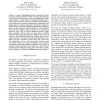Free Online Productivity Tools
i2Speak
i2Symbol
i2OCR
iTex2Img
iWeb2Print
iWeb2Shot
i2Type
iPdf2Split
iPdf2Merge
i2Bopomofo
i2Arabic
i2Style
i2Image
i2PDF
iLatex2Rtf
Sci2ools
IROS
2007
IEEE
2007
IEEE
Learning humanoid reaching tasks in dynamic environments
— A central challenging problem in humanoid robotics is to plan and execute dynamic tasks in dynamic environments. Given that the environment is known, sampling-based online motion planners are best suited for handling changing environments. However, without learning strategies, each task still has to be planned from scratch, preventing these algorithms from getting closer to realtime performance. This paper proposes a novel learning-based motion planning algorithm for addressing this issue. Our algorithm, called the Attractor Guided Planner (AGP), extends existing motion planners in two simple but important ways. First, it extracts significant attractor points from successful paths in order to reuse them as guiding landmarks during the planning of new similar tasks. Second, it relies on a task comparison metric for deciding when previous solutions should be reused for guiding the planning of new tasks. The task comparison metric takes into account the task specification and as wel...
| Added | 03 Jun 2010 |
| Updated | 03 Jun 2010 |
| Type | Conference |
| Year | 2007 |
| Where | IROS |
| Authors | Xiaoxi Jiang, Marcelo Kallmann |
Comments (0)

